Updated: 04-Jan-2024
This is the “Socièté d’Etude de la Propulsion par Reaction” created on the basis of SCEPR in 1944.
-Later, in 1969, SEPR would join Snecma, creating SEP.
-They would also absorb LRBA in 1971.
-As has been said, at SEP the engines are the same.
-As additional details we will present those known as typically from SEPR. As they were previous, they made a series of interesting essays.
-In a publication from the 1950s, the principle of a SEPR rocket engine appeared. This engine, in addition to propelling the corresponding vehicle, fed the turbopumps.
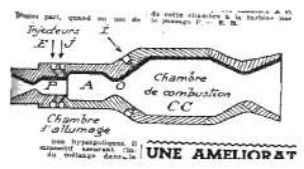
“Propeleur-fusée motor”
-Known as propeller-fusée (propellant-rocket) it had a chamber "A" where - through "J" - self-inflammable hypergolic fuel was consumed.
-This kept the flame to the main combustion chamber "CC" where other non-hypergolic fuels were injected, through "I".
-Combustion in "A" also ensures the rotation of the turbopump due to the gases leaving through "P".
-Once the engine has started, it stops feeding chamber A with hypergolic fuels.
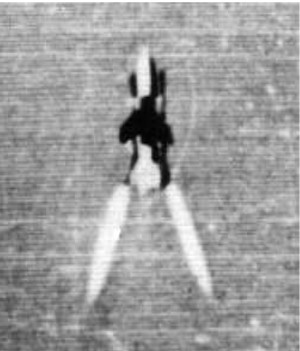
“Sncase 4100”
-Later the SE4100 missile would use the SEPR 2020.
-Other tests were a carriage launched by a SEPR 9 rocket and braked with a SEPR 15.
-There were other types of engines for missiles such as the 12, 16, 25, 43 or 45. The 16 was used on the first French A-A missile.
-The above mentioned SE 2020 is shown below at the Villaroche Museum. It gave a thrust of 1350 DaN for 182 sec. Its studies started in 1948.
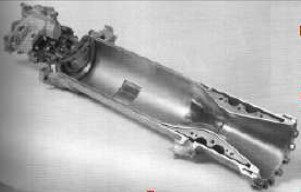
“SE 2020, cutaway” (PiP)
-This type of combustion chamber is what we are going to see in later engines, dedicated to aircraft propulsion.
-During the 1950s, numerous tests were carried out on experimental airplanes, including normal ones and not just as “boosters” but with mixed propulsion.
-We have seen them both on SO (Sud-Ouest) and Snacaso planes.
-The SO known as Trident had a Viper engine for sustainment and a triple SEPR as booster.

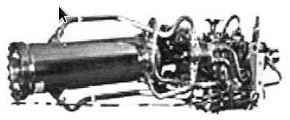
“Two SEPR 25”
-The 25 began its career in 1948, giving about 1,500 DaN of thrust for 200 sec.
-The “Espadón” of Snacaso also had a SEPR 25.
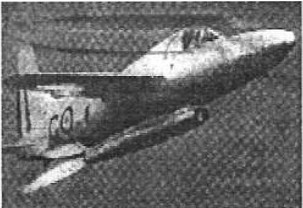
“Espadón”
-The first Trident, the SO-6025 used a Hispano-Suiza turbojet engine and a SEPR 25.
-A SEPR 251 version was used on the SO-6026.
-As we see there are heads of series like 25 that would give 251, etc.
-Series 65, 651; 66 would give 660 and 661.
-There were the 63 series giving 631, and the 84 giving 841, 844, as if they were families.
-The 481, with 4,500 kgf of thrust, was mounted on the Trident-I, the SO-9000. This was a coupling of three SEPR-25 engines.

“SEPR 481”

“Trident with Marborés at the wingtips”
-On the Trident II, SO-9050, the 63 and 631 were mounted. The latter gave about 3,000 DaN of thrust.
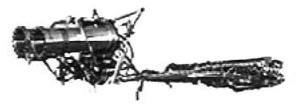
“SEPR 631”
-The 25 used nitric acid plus a fuel called TX from SEPR, and on the 481 and 631 nitric acid and Furaline III were injected.
-With the 65 the fuel changes to TX-II (in addition to nitric acid as an oxidizer), delivering 712 DaN.
This engine is used by Snacase's Durandal, a SE-212 light interceptor, which did not prosper.
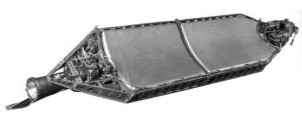
“SEPR 65”
-This is a complete installation that fits under the fuselage and includes the two ergole tanks. On the right we see - hanging - the connector that joins it to the plane's control. The main engine was an Atar 101.

“SEPR 633”
-Destined for a variant of the Mystere IV, the 633 used more complex fuels such as a mixture of Xylidine and Triethylamine, together with nitric acid as an oxidant. It had two combustion chambers and gave 15 KN with one chamber or 30 KN with both.

“SEPR 66”
-It lies in the 1,500 Kgf thrust range, using Furaline mounted on the Mystere IV.
-And derived from the above mentioned engine are the 660 and 661 giving 1,500 KN and 1,645 KN respectively. They run on nitric acid and Furaline III, and they have two chambers.
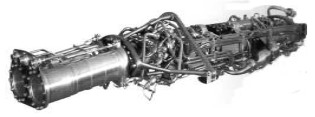
“SEPR 660/661”
-Based on the 631, the 81 comes out in 1956. It has an adjustable thrust from 500 to almost 3,000 DaN. with a duration of 210 seconds. It was planned for the Super-Vautour.

“SEPR 81”
-The SEPR 81A gave 3,200 DaN (7,050 lbf). It had two combustion chambers like the 81.
-It has a completely automatic control, with the pilot having the start button and gas control. It runs on nitric acid and kerosene.

“SEPR 81A”
-Now we come to the rocket motors that are used by the Spanish Mirage III. It is the 844.
-It gave a thrust of 12.5 DaN for 192 seconds, and it used the same fuel as the SEPR-81.
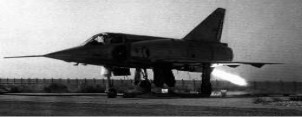
“Mirage in static test”
-The 844 engine in the SEP chapter has a cutaway tank for educational purposes. Here it appears complete.

“SEPR 844”
-It runs on nitric acid and a triethylamine compound with xylidine.
-The 841 was similar, with a thrust of around 1,500 Kgf, adjustable to half of it if desired.
-One detail: the feed pump was on the plane's main engine.
-Many engines designed by SEPR were manufactured by Hispano-Suiza.
-The engines for missiles such as the H2, H3, HM4 and HM7 discussed in the SEP chapter are the same ones that began their life in SEPR.

“SEPR HM4”
-Another little-known liquid fuel engine is the C-2 with four combustion chambers. It seems to be a “gimballing” engine, that is, adjustable nozzles for controlling the trajectory.
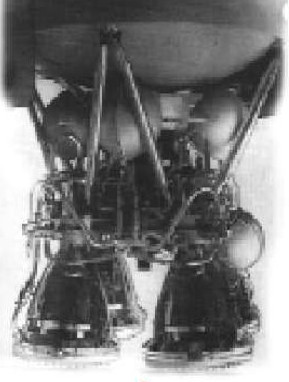
“SEPR C-2” (PeT)
-With the 904 we begin to treat some SEPR solid fuel engines.
-It is an engine with four nozzles, entering service in 1971 for missiles fired from submarines, or MSBS. They were of the M1, M2 and M20 type.
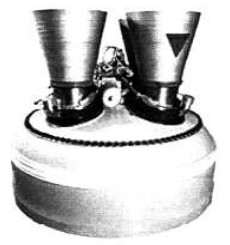
“SEPR 904”
-The solid fuel was “Isolane”, for a total thrust of 440 KN for 264 seconds.
-Other engines used on missiles or as lifting components (Boosters) of heavier vehicles may be the following:
-The 681 giving more than 11,000 Kgf of thrust.
-The 706, 1,500 Kgf.
-The 734 of more than 23,000 Kgf
-The 163, 140 Kgf.
-The 6854, of almost 4,000 Kgf used on the third stage of the ONERA vehicle “Antarés”.
-The 738, giving 8750 Kgf of thrust.
-The 739, with 16,600 Kgf of thrust was used on missiles such as the ONERA “Berenice”, “Titus”, “Tacite”, “Tibere”, etc.

“SEPR 739, Stromboli”
-The “Tramuntane”, the solid fuel rocket engine SEPR 200, delivered 5,000 KN for 7 seconds.
-Production is much more extensive, capable of supplying most French manufacturers of ground-to-ground, ground-to-air, air-to-air, air-to-surface projectiles, etc.
-And other propulsion systems such as the one exhibited at an Air Show, the SEPR 684 on a strange vehicle.
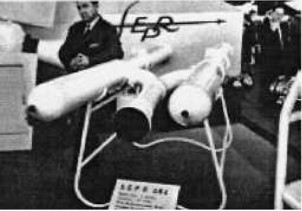
“SEPR 684”
-In fact, it is a guided missile, with two solid fuel 684 side rockets for assistance. It is from 1956.
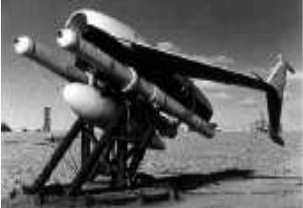
“SFENA SE4500 with SEPR 684”
-SEPR also made Auxiliary Power Generator engines, known as the GAP line. (APU, APP).
-Apart from the Thrusters seen at SEP, we mention an experiment known as “Solar Engine”, using the thermal energy of the Sun, which on Earth is approximately 1.36 kW per m2.
-This is the PES-2 installed on the “Phaeton”. A 4-meter-diameter parabolic mirror directed toward the Sun collects its energy and sends it to a mercury cauldron.
-This is an experiment from the late 1940s or early 1950s. The mercury vapors that are obtained and are used as an agent, are directed to an improved steam engine that drives an alternator.
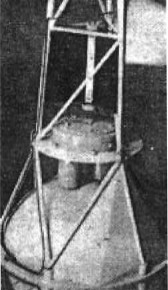
“Phaeton”
-Electricity reheats the hydrogen stored in a liquid hydrogen tank. The gases are evacuated through ejectors that provide a thrust of 20 grams, enough to regularize the trajectory of a satellite weighing hundreds of kilos.
-The mercury boiler is a closed circuit, returning to the boiler once condensed, in two stages.

“Logo SEPR”
-The SEPR S-178 engine was specially developed for the “Ludion” single-person support vehicle designed by Sud-Aviation.
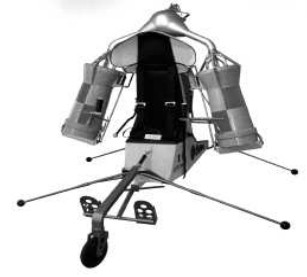
“Ludion”
-It is an engine running on isopropyl nitrate, a monopropellant driven by compressed air from a tank through a decomposition catalyst. The injectors discharge it into nozzles made by the Bertin Company. In fact, they are augmenting venturis with control shutters at the exit.
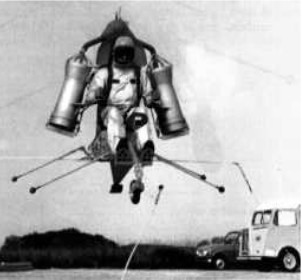
“Ludion trials between 1968 and 1969”
From Appendix 6: Here are more of the brand's engines and rocket series with “gemstone” names.
-First the Topaze with four nozzles and solid fuel.
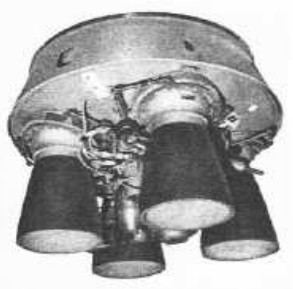
“SEPR nozzles for Topaze”

“Rubis second stage engine”
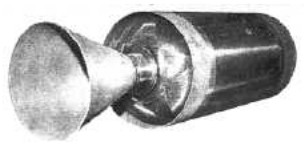
"Diamant third stage engine"
-In the second series of Diamant rockets the engines became “high energy”, on the left that of the second stage.
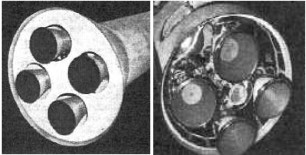
“Two SEPR engines for the Diamant”
-The one on the right is from the third stage and below the one from the first stage.
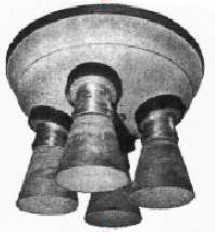
“First stage of the second Diamant series” (PeT)
-The Diamants were important carrier rockets for the French program and with which they managed to put several satellites into orbit.
-In its best time, around 1973, the Diamant A, the B and the last BP4 were known. Many of the launches were made on behalf of ESRO, the European Space Research Organization.
-At that time SEPR was still SEP (see both) and was dedicated to the manufacture of engines while the SNPE produced solid fuels. Marketed by the GPP (Groupement pour la Propulsion a Poudre).
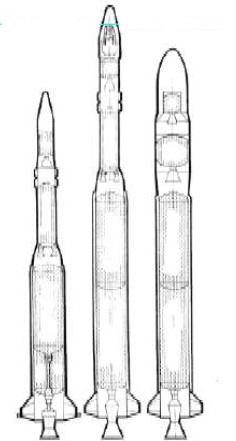
“The Diamant A, B and BP4” (PeT)
-We observe that in the first stages, engines with liquid fuels are used and in the second and third stages they have solid fuels. (See SEP and SEPR).
-Curious photo of a primitive Diamant, 1st phase, with the Emeraude engine (which would inherit SEP and SEPR from LRBA).
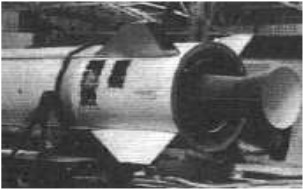
“Diamant rocket with Emeraude, year 1967”
From Appendix 7: SEPR came from SCEPR or Civil Society for the Study of Reaction Propulsion. After WWII, it had its headquarters in the city of Paris, in separate apartments on Saint Lazare and Acacia streets.
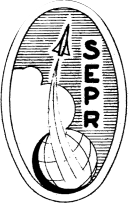
“The first SEPR logo”
-The work centers were in Argenteuil and Villejuif. Another one in Toulouse passed to Istres and would end up in Villaroche (Nord).
-A first job was done on a German Walter T500, (109-T500) for takeoff assistance (see Walter). Exhaustive tests were carried out, leading to a two-chamber variant being available.

“A Walter used by SEPR for testing”
-Clearly a T500 for take off aid. This engine belonged to the lots of material recovered from the Germans. The variant with two chambers that was tested was known as the T1000 and was also recovered.

“The twin-chamber T1000”
-From the Germans they also had a BMW 718, a V1, as well as a Rhursthal Kramer air-to-air missile. All of them were studied in depth.
-However, it is striking that they made an exotic annular wing type ramjet that was attached to a SEPR 24 rocket following the idea of Zborowski's circular wing.
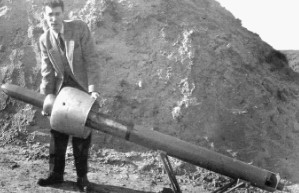
“The mentioned ramjet”
-The first operational rocket engine in numerical order is the SEPR 2.
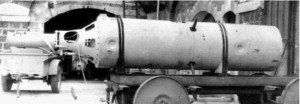
“The SEPR 2 on SEP carriage”
-We see it at the Villejuif factory, it gave 1,350 DaN of thrust for 31 seconds. Below we see it in tests.
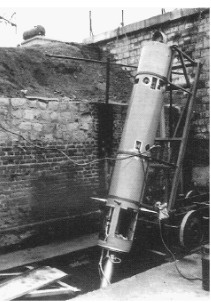
“The SEPR 2 in a kind of blockhouse”

“Another test of SEPR 2”
-Much later the SEPR 2020 would be from the same family.

“SEPR 2020”
-It was intended for Snacase's SE 4100 missile. It used other booster engines for takeoff, the SEPR 4.

“A SEPR 4, help engine”
-The Matra M04 missile would use the SEPR 12 engine.
-The SEPR 16 engine was a small engine, built in series for a missile based on the German Kramer, the small X4 missile.
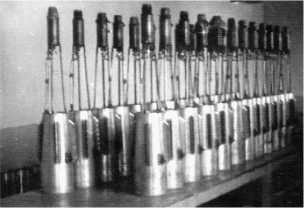
“SEPR 16 engine group”

“Preparations for the X4”
-A small list of the most common operating SEPR motors would be as shown below:
-The SEPR 25 used on the Espadon.
-The SEPR 48 on Trident I.
-The SEPR 63 on the Trident 2.
-The SEPR 65 on the Durandal.
-The SEPR 66 on the Mystere IV and Mirage I.
-The SEPR 84 on the first Mirage III aircraft.
-The SEPR 840 on the Mirage III A.
-The SEPR 841, widespread on the Mirages that followed.
-And the SEPR 844 on the Mirage IIIE.

“The SEPR 25”
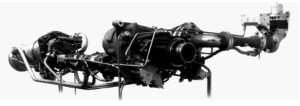
“The SEPR 84 from the rear”
-Up to this point we have seen the use of rockets as weapons. It turns out that the space age was entered and a new family of engines would enter the scene.
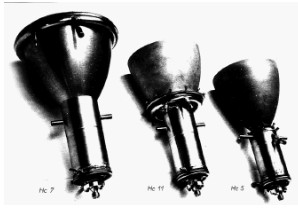
“Multi-chamber try-outs”
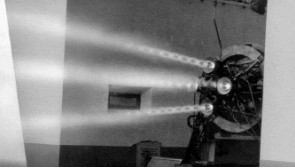
“Functional test of the HM4 cluster”
-Photograph of the book “La légende d’un demi-siecle” (de moteurs Fusées) edited by SAFRAN. It is considered a history of Villaroche-Nord, from 1953 to 1980.
-The HM3 and HM4 were important, but the HM7 was the first cryogenic, used on the Ariane 4 and later on the second stage of the Ariane 5, replacing the Aestus.
-The Astrium group has been involved in two important engines, the 2330 DaN Astris running on N2O4/Aerozine 50 and the Aestus with 3,000 DaN and using N2O4 and MMH.
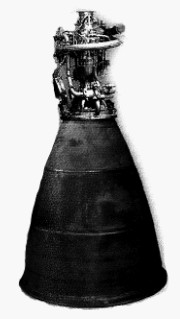
“The Aestus Engine” (from Astrium)
-The Aestus was made for the second stage of the Ariane 5 (V).
-During the changes from SEPR to SEP, from the 1960s to the 1970s, the small one-person Ludion helicopter with a rocket engine and Bertin augmenters was tested. See main text.
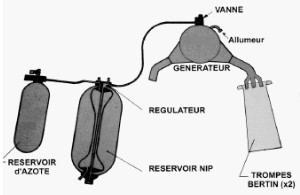
“Ludion engine diagram”
-The maximum thrust of this engine was 220 DaN but it could only run for 32 seconds!
-Therefore, it was not operational, being just an experiment.
-Like the US and the USSR, nuclear rocket engines using liquid hydrogen were studied.
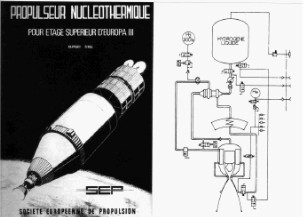
“Appearance and diagram of the atomic engine”
-Collaborating with ONERA, even with mutual contracts, more engines are developed such as the one that operates with litergoles (MT13 of 1000 DaN, for example).

“MT13 Engine, Onera-Sepr”
From Appendix 9: Another list of rocket motors made by this company to contrast with those that appear in the main text.
-Melanie.
-SEPR-16
-SEPR-2
-SEPR-200
-SEPR-25
-SEPR-43
-SEPR-740
-685-4 (+Onera)
-734-1
-737
-739 (Stromboli)
-739-2
-740-3
-P-163 (+Matra)
-P-167
-P-191
-732 (+Sud)
-Stromboli
-Tramontana
Engines of SEPR
Model: 685-4 (+Onera)
Arquitecture:
Chambers:
Fuels:
Feed System:
Ignition:
Thrust:
Weight:
Model: Aestus 3000 DaN
Arquitecture:
Chambers:
Fuels:
Feed System:
Ignition:
Thrust:
Weight:
Model: Astris 2230 DaN
Arquitecture:
Chambers:
Fuels:
Feed System:
Ignition:
Thrust:
Weight:
Model: HM-3
Arquitecture:
Chambers:
Fuels:
Feed System:
Ignition:
Thrust:
Weight:
Model: HM-4
Arquitecture:
Chambers:
Fuels:
Feed System:
Ignition:
Thrust:
Weight:
Model: HM-7
Arquitecture:
Chambers:
Fuels:
Feed System:
Ignition:
Thrust:
Weight:
Model: Melanie
Arquitecture:
Chambers:
Fuels:
Feed System:
Ignition:
Thrust:
Weight:
Model: MT-13 (with Onera)
Arquitecture:
Chambers:
Fuels:
Feed System:
Ignition:
Thrust:
Weight:
Model: P-163 (Matra)
Arquitecture:
Chambers:
Fuels:
Feed System:
Ignition:
Thrust:
Weight:
Model: P-167 (SEP)
Arquitecture:
Chambers:
Fuels:
Feed System:
Ignition:
Thrust:
Weight:
Model: P-191 (Matra)
Arquitecture:
Chambers:
Fuels:
Feed System:
Ignition:
Thrust:
Weight:
Model: S-178
Arquitecture:
Chambers:
Fuels:
Feed System:
Ignition:
Thrust:
Weight:
Model: SEPR-12
Arquitecture:
Chambers:
Fuels:
Feed System:
Ignition:
Thrust:
Weight:
Model: SEPR-16
Arquitecture:
Chambers:
Fuels:
Feed System:
Ignition:
Thrust:
Weight:
Model: SEPR-2
Arquitecture:
Chambers:
Fuels:
Feed System:
Ignition:
Thrust:
Weight:
Model: SEPR-200 (Tramontane)
Arquitecture:
Chambers:
Fuels:
Feed System:
Ignition:
Thrust:
Weight:
Model: SEPR-2020
Arquitecture:
Chambers:
Fuels:
Feed System:
Ignition:
Thrust:
Weight:
Model: SEPR-24
Arquitecture:
Chambers:
Fuels:
Feed System:
Ignition:
Thrust:
Weight:
Model: SEPR-25
Arquitecture:
Chambers:
Fuels:
Feed System:
Ignition:
Thrust:
Weight:
Model: SEPR-4
Arquitecture:
Chambers:
Fuels:
Feed System:
Ignition:
Thrust:
Weight:
Model: SEPR-43
Arquitecture:
Chambers:
Fuels:
Feed System:
Ignition:
Thrust:
Weight:
Model: SEPR-48
Arquitecture:
Chambers:
Fuels:
Feed System:
Ignition:
Thrust:
Weight:
Model: SEPR-481
Arquitecture:
Chambers:
Fuels:
Feed System:
Ignition:
Thrust:
Weight:
Model: SEPR-63
Arquitecture:
Chambers:
Fuels:
Feed System:
Ignition:
Thrust:
Weight:
Model: SEPR-631
Arquitecture:
Chambers:
Fuels:
Feed System:
Ignition:
Thrust:
Weight:
Model: SEPR-633
Arquitecture:
Chambers:
Fuels:
Feed System:
Ignition:
Thrust:
Weight:
Model: SEPR-65
Arquitecture:
Chambers:
Fuels:
Feed System:
Ignition:
Thrust:
Weight:
Model: SEPR-66
Arquitecture:
Chambers:
Fuels:
Feed System:
Ignition:
Thrust:
Weight:
Model: SEPR-684
Arquitecture:
Chambers:
Fuels:
Feed System:
Ignition:
Thrust:
Weight:
Model: SEPR-685-4 (Onera)
Arquitecture:
Chambers:
Fuels:
Feed System:
Ignition:
Thrust:
Weight:
Model: SEPR-732 (Sud)
Arquitecture:
Chambers:
Fuels:
Feed System:
Ignition:
Thrust:
Weight:
Model: SEPR-734-1 (Onera)
Arquitecture:
Chambers:
Fuels:
Feed System:
Ignition:
Thrust:
Weight:
Model: SEPR-737 (Onera)
Arquitecture:
Chambers:
Fuels:
Feed System:
Ignition:
Thrust:
Weight:
Model: SEPR-739 (Stromboli)
Arquitecture:
Chambers:
Fuels:
Feed System:
Ignition:
Thrust:
Weight:
Model: SEPR-739-2 (Onera)
Arquitecture:
Chambers:
Fuels:
Feed System:
Ignition:
Thrust:
Weight:
Model: SEPR-740, -3 (Onera)
Arquitecture:
Chambers:
Fuels:
Feed System:
Ignition:
Thrust:
Weight:
Model: SEPR-81
Arquitecture:
Chambers:
Fuels:
Feed System:
Ignition:
Thrust:
Weight:
Model: SEPR-84
Arquitecture:
Chambers:
Fuels:
Feed System:
Ignition:
Thrust:
Weight:
Model: SEPR-840
Arquitecture:
Chambers:
Fuels:
Feed System:
Ignition:
Thrust:
Weight:
Model: SEPR-841
Arquitecture:
Chambers:
Fuels:
Feed System:
Ignition:
Thrust:
Weight:
Model: SEPR-844
Arquitecture:
Chambers:
Fuels:
Feed System:
Ignition:
Thrust:
Weight:
Model: SEPR-904
Arquitecture:
Chambers:
Fuels:
Feed System:
Ignition:
Thrust:
Weight:
Model: SEPR-C-2
Arquitecture:
Chambers:
Fuels:
Feed System:
Ignition:
Thrust:
Weight:
Model: T-1000 (2 chambers)
Arquitecture:
Chambers:
Fuels:
Feed System:
Ignition:
Thrust:
Weight:
Model: T-500
Arquitecture:
Chambers:
Fuels:
Feed System:
Ignition:
Thrust:
Weight:


